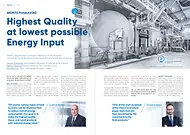Can you talk in-depth about energy savings, and perhaps provide some numbers?
PAUL RICHARDS: TAD by its very nature is rather energy intensive, which is one of the key reasons the market has developed so much in the US, where energy is traditionally so much cheaper than in other regions. What we are seeing today, however, is an interest from regions where energy is much more expensive, but where a market can still be developed if a way can be found to reduce the energy consumption.
Historically, TAD was made with a dryness after the TAD of around 95% – one of the reasons that led to the development of the UCTAD, or Un-Creped TAD, process. The Yankee, a traditional part of any Tissue Machine, was only really a carrier, allowing a percentage of dry crepe to be put into the end product. Today, depending on the technology being used and the manufacturer, the dryness after the TAD can be significantly lower. In fact, ANDRITZ and its customers are constantly making efforts to push these boundaries and are evolving with the chemistry suppliers to allow higher moisture to the Yankee. This movement of the drying balance is a major step in reducing the energy demand for drying.
From the time of the development of our first TAD machine to the current offering, we have reduced the drying energy demand in the range of 15 – 20% by the simple use of a second TAD drum, albeit smaller diameter drums. This allows a more controlled and targeted use of the hot air in the drying process. We can use much hotter air for the first air system, which also has a lower permeability of the tissue sheet, where the pressure drop is considerably higher. Then in the second system, where the sheet is drier and more open, we can use lower temperatures and higher volumes. All of this protects the other system components, such as the TAD fabric, while allowing smaller overall system components and commonality between the system sizes.
Taking this line a little further, our drive is now to further push the balance of the drying towards the Yankee, with a target around 65% max solids to the cylinder. This can only be achieved in conjunction with our customers and our partners in the chemical side of our industry. Financially, however, if such a movement can be realized, then the energy efficiency of the drying process could finally be at an optimal level. Once all the “free water” has been removed and only intercellular water is left, the impingement process is much more efficient from a drying perspective.
Another recent addition to energy saving opportunities comes from developments in vacuum technology. Using blowers instead of traditional liquid ring pumps provides a hot air source that can be used for preheating a portion of the incoming air as it enters the system.
Another possibility, probably more popular in places where gas supplies are more limited or infrastructure is not yet available, is the use of steam (heat exchangers) as a heating medium. The system temperatures lend themselves to consideration of such heat exchangers, especially in situations where an excess of steam is available, such as near pulp plants, etc.




